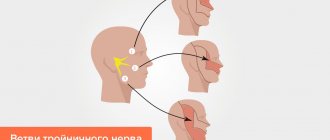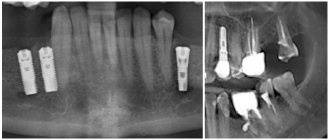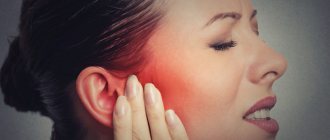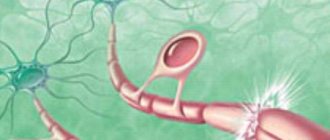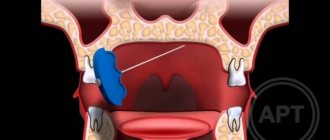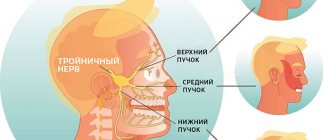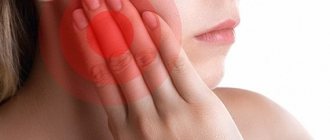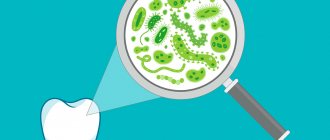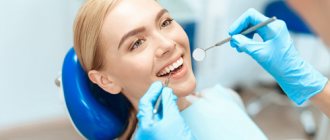Causes of inflammatory damage to the trigeminal nerve
Factors contributing to inflammation of the trigeminal nerve are:
- surgical interventions on the jaw bones;
- fractures of the base of the skull, lower and upper jaws;
- tumors;
- complex tooth extraction;
- hypothermia;
- surgery on the maxillary sinus;
- improperly administered anesthesia;
- incorrectly performed dental prosthetics;
- metabolic disorders;
- the presence of foreign bodies that irritate the nerve trunk or injure nerve endings;
- bacterial or viral infection;
- various types of intoxication of the body;
- hypovitaminosis;
- weakening of the immune system.
The main symptoms of inflammation of the ternary nerve
What are the main symptoms of trigeminal nerve inflammation and tooth pain? The location of the pain and its nature will depend on which nerve endings are inflamed. If it is the lower trigeminal nerve, then discomfort will be felt in the lower jaw. With inflammation of the middle trigeminal nerve - in the upper jaw. Inflammation of the superior trigeminal nerve causes pain to spread to the upper part of the face (eyes, forehead, temples and even ears).
With neuralgia, teeth can hurt either constantly or periodically (paroxysmal pain). Unpleasant sensations can begin suddenly and end just as unexpectedly. Sometimes it can be very difficult to identify the exact location of pain.
How do teeth hurt with trigeminal neuralgia? Discomfort can manifest itself as ordinary toothache or migraine. But, characteristically, this pathology never causes edema.
Symptoms of trigeminal neuritis
The maxillary trigeminal nerve consists of three types of nerve fibers:
- vegetative;
- motor;
- sensitive.
The symptomatic picture of neuritis may vary depending on which fibers were affected by the inflammatory process.
Damage to sensory fibers
In particular, with inflammation of the sensory fibers, the patient may complain of a tingling sensation, numbness, and weakened sensitivity in the area innervated by the trigeminal nerve.
Damage to motor fibers
When motor fibers are damaged, there is a partial or complete decrease in strength in the innervated muscles, their atrophy and deterioration of tendon reflexes.
Damage to vegetative fibers
When the vegetative fibers are inflamed, the patient experiences cyanosis and swelling of the skin, dryness and thinning of the skin, and the potential risk of developing a trophic ulcer increases.
Facial neuritis causes, symptoms, treatment and prevention methods
Massage
First, the exclusively healthy side of the face, the collar area, is massaged, therapeutic exercises, and positional treatment are performed.
The purpose of the massage is to neutralize swelling and congestion, improve lymph and blood circulation in the facial muscles, restore the conduction of nerve impulses along the facial nerve and the function of facial muscles, and prevent the development of contractures. For a positive result, on average, 10 to 20 sessions of 5–15 minutes are required, depending on the degree of nerve damage, the dynamics of recovery, and the goals of therapy. In the early period, a gentle acupressure of the face, neck, collar area, and shoulder girdles is performed using stroking, rubbing, kneading, and vibration. Facial massage is not prescribed for atherosclerosis, active tuberculosis, high fever, blood diseases, or oncology.
Physiotherapy
Physiotherapy for neuritis of the facial nerve helps to alleviate the severity of symptoms, improve conductivity and restore the functions of the facial nerve, and activate microcirculation and metabolic processes. The procedures combine well with drug treatment, are safe when used correctly, cause virtually no adverse reactions, are painless, and have a long-lasting effect.
From the first day of treatment for facial neuritis, physiotherapy is prescribed in the form of non-contact heat, positioning treatment, and adhesive plaster tension. From 5–6 days, the following physiotherapy procedures are performed according to indications:
- therapeutic effect of an ultra-high frequency electric field
- ultrasound
- electrophoresis of drugs
- transcutaneous electrical nerve stimulation;
- myoelectrostimulation
- local darsonvalization (exposure to tissue with low-power alternating electric current)
- microwave therapy
- laser blood irradiation
- ozokerite treatment
Drug treatment
The doctor recommends drugs for the treatment of facial neuritis in the case of a particular patient, paying attention to the causes and characteristics of the course of the disease, the severity of symptoms, and the presence of concomitant pathologies.
The standards of drug treatment for facial neuritis include:
- analgesics
- decongestants
- B vitamins
- antiplatelet agents
- non-steroidal anti-inflammatory drugs
- vasodilators
Usually, for neuritis of the facial nerve, tablets are prescribed. To enhance their effect, an ointment or gel with an analgesic, local irritant, and warming effect is used externally. If necessary, to achieve the desired effect as quickly as possible, medications are administered intramuscularly.
With slow nerve recovery, glucocorticosteroids are prescribed, drugs that improve metabolic processes in the nervous tissue. If complete recovery does not occur within two to three months, the treatment program includes biostimulants and hyaluronidase. In case of secondary neuritis of the facial nerve, the underlying disease is treated simultaneously with symptomatic therapy.
Surgery
In case of complete rupture of the facial nerve, congenital neuritis, and lack of effect from conservative therapy after 7–11 months, surgery is necessary. In order to restore the conductivity of the facial nerve and the motor functions of the facial muscles, stitching and plastic surgery of the damaged nerve trunk are performed. To reduce the cosmetic defect, plastic surgery of the facial nerve is performed using autotransplantation. If there is a significant decrease in hearing, hearing aids are performed.
Surgical treatment makes sense during the first year of the disease; later, irreversible atrophy of the facial muscles occurs.
Other treatments
In the complex treatment of facial nerve neuritis, acupuncture is used. Sterile single- or reusable needles are inserted into pre-selected points at different depths, which are heated and rotated to enhance the therapeutic effect. Other treatment and rehabilitation measures help restore the functions of the facial nerve and facial muscles, and neutralize the symptoms of neuritis:
- reflexology
- biofeedback (biofeedback training)
- immunosorption (selective purification of blood from antibodies and antigens)
- local medicinal baths
- facial taping (adhesive tape tension)
- mask made of clay, paraffin
- botulinum toxin injections to eliminate muscle contractures
Pain due to inflammation
In addition, a disease such as inflammation or neuritis of the facial trigeminal nerve makes itself felt with attacks of pain of a very diverse nature:
- cutting,
- burning,
- pricking,
- tearing
- shooting, etc.
In this case, the area of pain does not always correspond to the area of innervation and can spread to the lower jaw, cheeks and chin.
Pain may be accompanied by:
- muscle spasms (facial, chewing),
- the appearance of nasal discharge,
- development of hypersalivation,
- increased lacrimation.
Lack of sensation in the tongue, lips and chin
With inflammatory damage to the trigeminal nerve, not only the entire nerve can be damaged, but also its individual branches. This is why numbness and pain can occur in various areas of the face. For example, when the lingual branch of the nerve is inflamed, patients complain of pain and sensitivity disturbances in the anterior part of the tongue, and when the mental branch is damaged, in the area of the lips and chin.
Pain when laughing, chewing, brushing teeth and shaving
Pain due to neuritis of the maxillary trigeminal nerve can intensify with touching, chewing, laughing and with changes in temperature. That is why patients, trying to prevent the recurrence of painful attacks, avoid excessive mobility and prolonged conversations, and refuse brushing their teeth and shaving.
Symptoms of neuritis, neuropathy, inflammation of the facial nerve
The essence of the symptoms is the disconnection from the brain of those areas whose function is controlled by the facial nerve:
- Weakness or paralysis of the facial muscles of one half of the face, which is expressed in the inability to raise the eyebrows, close the eyes, blink, wrinkle the nose, smile, puff out the cheeks (sail symptom); sometimes you feel the chin being pulled down, tension in the subcutaneous muscle of the neck;
- As a result of the disconnection of the facial muscles, a drooping of the corner of the mouth and smoothness of the nasolabial fold may be noticeable;
- As a result of the shutdown of the cheek muscles, it may be difficult to eat liquid foods;
- Sometimes the symptoms described above are accompanied by dry eyes or lacrimation, increased sensitivity to sounds (booming in the ear), decreased taste sensitivity, increased or decreased sensitivity of the facial skin on the affected side.
Treatment of neuritis of the maxillary trigeminal nerve
Therapy
The treatment program for trigeminal neuritis is drawn up taking into account the causes of the disease and its clinical signs. The main goals of treatment are:
- achieving a sensitizing effect;
- fight against bacterial and viral infection;
- increasing the body's immune forces;
- elimination of swelling of the nerve trunk;
- restoration of natural adaptive and compensatory reactions;
- normalization of the patency of nerve impulses.
Healing procedures
The set of procedures aimed at blocking the inflammatory process and eliminating all manifestations of neuritis includes:
- antibacterial therapy;
- antiviral therapy;
- elimination of factors contributing to the occurrence of intoxication;
- removal of tumor-like neoplasms or dissection of adhesions compressing the nerve;
- prescribing vitamin and mineral complexes to the patient;
- stimulation of nerves and muscles;
- acupuncture;
- physiotherapy (electrophoresis, phonophoresis, UHF, ultrasound, paraffin therapy).
People suffering from trigeminal neuritis are advised to regularly visit dental clinics and have their oral cavity sanitized.
Diagnostics
A neurologist diagnoses trigeminal neuralgia. During the first visit, he carefully interviews the patient to find out:
- complaints: nature of pain, its intensity and localization, conditions and frequency of attacks, their duration;
- medical history: when pain attacks first appeared, how they changed over time, etc.;
- life history: the presence of chronic diseases, previous injuries and operations is clarified, special attention is paid to dental diseases and interventions.
A basic examination includes assessing the condition of the skin and muscles, identifying asymmetry and other characteristic signs, checking the quality of reflexes and skin sensitivity.
To confirm the diagnosis, the following is carried out:
- MRI of the brain and spinal cord with or without contrast: allows you to identify tumors, consequences of injuries, vascular disorders; sometimes the study is replaced by computed tomography (CT), but it is not as informative;
- electroneurography: study of the speed of nerve impulse transmission through fibers; allows you to identify the fact of nerve damage, assess the level of the defect and its features;
- electroneuromyography: not only the speed of impulse passage along the nerve bundle is studied, but also the reaction of muscle fibers to it; allows you to assess nerve damage, as well as determine the sensitivity threshold of trigger zones;
- electroencephalography (EEG): assessment of the bioelectrical activity of the brain.
Laboratory diagnostics includes only general studies to exclude other causes of painful attacks, as well as to assess the condition of the body as a whole (usually a general blood and urine test is prescribed, as well as a standard set of biochemical blood tests). If the infectious nature of the disease is suspected, tests are carried out to identify specific pathogens or antibodies to them.
Additionally, consultations with specialized specialists are prescribed: ENT specialist (if there are signs of nasopharynx pathology), a neurosurgeon (if there are signs of a tumor or injury), and a dentist.
Causes and risk factors
Neuralgia of the trigeminal nerve branch is a disease with many possible causes. First of all, this is compression by vessels: displaced arteries or veins. Inflammation can also be provoked by metabolic disorders and diseases that are associated with them. These are diabetes mellitus, gout and other similar pathologies.
There are other possible causes of trigeminal neuralgia:
- inflammations that occur during dental treatment;
- hypothermia (general or facial area);
- mental disorders;
- purulent diseases of the jaw bones or skull;
- infection of the body with worms;
- chronic caries or sinusitis;
- infectious and viral diseases (herpes, adenoviruses, mumps, pulmonary tuberculosis, herpes zoster);
- very severe allergies;
- brain tumors;
- inflammation of the outer, middle or inner ear;
- multiple sclerosis;
- too narrow canal of the facial nerve from birth;
- injuries or operations on the temporal bone.
